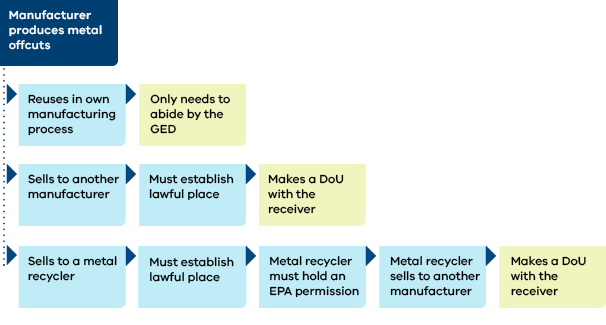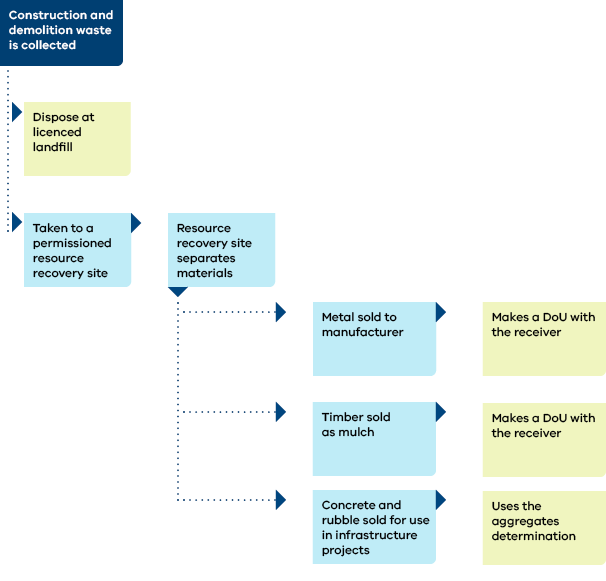A declaration of use (DoU) is a low-burden tool that enables a producer and receiver to meet their lawful place duties. The duty to deposit waste at a lawful place applies to all industrial wastes, including those intended for reuse or recovery.
The DoU is a self-assessed declaration that supports the safe reuse and recovery of materials from low-risk waste. It is a short two-page form that does not require EPA approval, notification or tracking.
The DoU includes a declaration from both the producer and the receiver. The producer makes a declaration that:
- describes your waste
- identifies legitimate uses for it
- assesses its risks to human health and the environment
- provides the end user with details about the quality and safety of your waste.
The receiver declares that the place or premises at which the waste is to be received is suitable to use the waste. Both producer and receiver must sign the DoU.
When to make a DoU
A DoU is suitable for industrial waste, priority waste or for reportable priority waste that requires tracking only. You can make a DoU when you intend to use your industrial waste immediately, without needing to process it further or store it or for a limited range of application to land scenarios.
Specifically, you can make a DoU for:
immediate use of
- waste for resource recovery
- waste other than soil for use as a substitute for an input or raw material in a commercial, industrial, trade or laboratory activity
- application of the following wastes to land:
- commercial garden and landscaping organics that do not contain any physical or chemical contamination
- untreated timber, including sawdust
- natural organic fibrous waste
Soil can be managed through a permission or a fill material determination. In most cases, a DoU would not be suitable and not required for managing soil. A DoU can only be used for soil if it is for immediate use of the soil for resource recovery and it is not being applied to land.
As per the Environment Protection Act 2017, resource recovery in relation to waste, means —
a) preparation for reuse of the waste
b) recycling the waste
c) reprocessing the waste
d) recovering energy or other resources from the waste
e) any waste that is prescribed for resource recovery purposes.
When a DoU is not appropriate
As per regulation 64 (3) of the Environment Protection Regulations 2021, you cannot make a DoU if your waste is reportable priority waste that requires a transport permission. You also cannot make a DoU if you are receiving waste for an activity that needs a permission. You do not need to make a DoU if a determination applies, such as for aggregates or fill material.
How to make a DoU
There are two options for making a DoU:
- Complete the approved EPA Declaration of Use form
- Develop your own DoU form that includes all the mandatory manner and form criteria, which are set out below.
You do not have to use the EPA Declaration of Use form to make a Declaration of Use. The EPA form has been developed to support duty holders to make a DoU in a broad range of circumstances. EPA recognises that in some circumstances, a duty holder or industry group may prefer to develop their own form. You do not need approval to use your own form – simply ensure that all criteria are included.
In those circumstances you must ensure the below information is included in order to meet the requirements of regulation 64 and the Authority’s (EPA) compliance and enforcement requirements. A DoU that includes all of the criteria set out below and is signed by the parties entering into that agreement, is in a form and manner approved by the Authority.
Criteria and details of a DoU
Producer details
Provide contact details for the producer, including:
- Business name and address
- ABN
- Contact name
- Phone number
Receiver details
Provide contact details for the producer, including:
- Business name and address
- ABN
- Contact name
- Phone number
Intended use
Set out the circumstance in which you are making a DoU for. You can only make a DoU for:
- immediate use of:
- waste for resource recovery
- waste other than soil to substitute for raw material; a commercial, industrial, trade or laboratory activity
- application of the following waste to land:
- commercial garden and landscaping organics that do not contain any physical or chemical contamination
- untreated timber, including sawdust
- natural organic fibrous waste
Type of waste
The producer must declare the type of waste that is being used.
Risks of harm
The producer must declare any risks of harm to human health or the environment that exist in relation to using the waste.
Minimising risks
Lawful place
The receiver must declare that the place or premises at which the waste is to be received is suitable to use the waste.
Consignment period
Set out if the DoU is for a specific consignment of industrial waste or for a specified period of time up to a maximum of 12 months.
Producer signature
The producer must sign the DoU to make the declaration.
Receiver signature
The receiver must sign the DoU to make the declaration.
Requirements and conditions
DoUs can be made for a one-off consignment of waste or for a specified period of time, up to 12 months. You won’t need a new DoU every time you produce or receive the same kind of waste.
Both the producer and receiver must retain a copy of the completed and signed DoU for 2 years from the date on which it was made. Penalties apply for non-compliance.
If after signing the DoU you become aware of any change in circumstance that makes the DoU inaccurate, then you must as soon as practicable notify the other signed party of the change. You will need to complete a new DoU form. Penalties apply for non-compliance.
An EPA authorised officer may ask to see your DoU. In addition, EPA may cancel a DoU or impose conditions on it by providing written notice to each person who made the declaration. A DoU has no effect from the time EPA provides written notice of the cancellation.
Examples
A DoU is only applicable for a limited number of applications. Below are two examples of when a DoU may apply.
Bike manufacturer produces scrap metal waste

Option 1: Offcuts are reused by the manufacturer in their own manufacturing process
-
No Declaration of Use required. The manufacturer only needs to abide by the GED.
Option 2: Offcuts are sold to another manufacturer as a replacement of virgin material.
- The manufacturer must establish lawful place.
- The manufacturer makes a declaration of use with the receiver.
Option 3: Offcuts are sold to a metal recycler
- The manufacturer must establish lawful place.
- The manufacturer ensures that the metal recycler is an EPA permissioned site
- The metal recycler sells on to a manufacturer as a replacement of virgin material. The metal recycler must make a DoU with the receiving manufacturer to establish lawful place.
Skip bin operator collects construction and demolition waste

Option 1: Waste is disposed of at a licenced landfill
Option 2: Waste is taken to a permissioned resource recovery site for processing
Resource recovery site separates received construction and demolition waste
Option 1: Metals are sold to a manufacturer as a replacement of virgin material
- DoU required with the receiver
Option 2: Timber used as mulch by a landscaper
- DoU required with the receiver
Option 3: Concrete sold for use in infrastructure projects
- Uses the aggregates determination
Read next
Find out about industrial waste
Reviewed 17 June 2021



